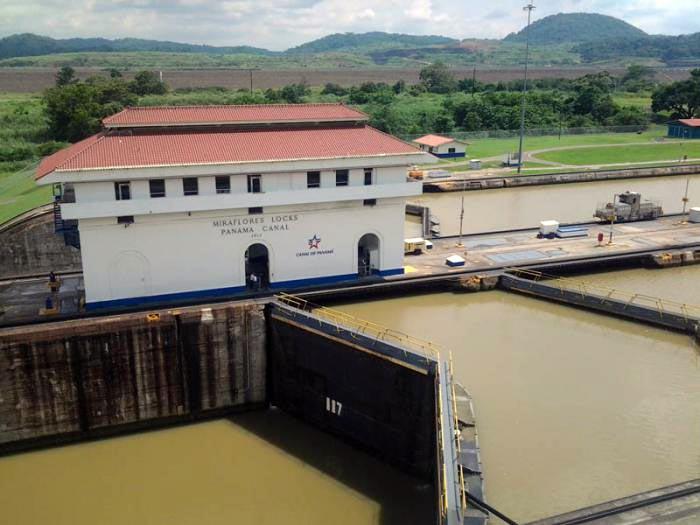
PANAMA.— More national pride than water flowed during the inauguration of the Panama Canal expansion which took place June 26. The project to increase the capacity of this engineering marvel is considered the country's most important accomplishment in a decade.
Popular excitement, the massive media deployment, and the contagious joy of showing off the Canal's expansion, took center stage in Panama, drawing in natives and visitors alike.
Granma International was able to witness the environment and events, prepared with the smallest detail in mind throughout the capital, known as the hub of the Americas, reflecting the multiple opportunities and commitments implied by the Canal's expansion.
Edwin Miranda, guide at the Miraflores visitors center, offered an inside view of what had been done as the new locks were opened at both the Pacific terminal at Coculí and at Agua Clara, on the Atlantic side.
For the first time, merchant ships of the Neopanamax type made their way through the Canal and into the news, since their greater capacity represents the most significant expected impact of the works, adding competitive credentials to the route in a market looking toward more trade.
Edwin discussed commercial advantages and expanded maritime traffic given access now available to larger ships, explaining that the 5.25 billion dollar project will double the Canal's capacity, and adding, "The entire route through the Canal, ocean to ocean, is approximately 80 kilometers long, and takes between eight and 10 hours."
More than 60 delegations, with more than 2,000 invited guests, witnessed the official opening of the promising expansion, at the Atlantic access point in Agua Clara, in the province of Colón.

The Cuban group was led by First Vice President Miguel Díaz-Canel Bermúdez, and included Deputy Foreign Minister Ana Teresita González Fraga and the country's Ambassador in Panama, Antonio Miguel Pardo Sánchez.
During the inauguration ceremony, Panamanian President Juan Carlos Varela noted the value of the Canal in connecting the Americas and the world, a role taken on as a vocation by the nation.
The ship with the privilege of being the first to travel through the new section is of Chinese origin, and has been given a new name, the Cosco Shipping Panama, a tribute to this singular honor and becoming a newspaper headline.
According to statements by Panama’s Minister of Agricultural Development, Jorge Arango, on the occasion of the 6th Sustainable Livestock Global Agenda meeting, another one of the expansion’s repercussions is the strategy to harmonize the development of livestock ranching in the Canal’s basin and environmental protection.
Representatives of the Panama Canal Authority noted that this specific alliance between ranchers and environmentalists reflects the fact that public policies have been promoted along these lines, along with a strong public relations campaign of environmental education and sustainable management which involved a heterogeneous group of participants, including experts in different areas, producers, and government.
Such efforts were highlighted during the inauguration, as the country continues to recover from the effects of the most destructive El Niño weather pattern in almost 20 years.
When asked about the noticeable energy reflected in Panamanians’ Canal pride, Edwin explained it as a result of the country’s history and leaving behind the bitterness of U.S. control of the Canal, which made Panamanians feel like strangers in their own land.
He cited a revealing detail, “Look, in those times, the Canal workforce was 2% Panamanian and 98% from abroad. Now the ratio has been inverted,” meaning greater job opportunities and income, plus a guarantee that earnings from the locks are invested to benefit the Panamanian people.
The Canal’s principal connecting ports are welcoming the expansion as well, looking to take advantage of greater opportunities and maximize their participation.
Ports in the United States, primary destination and departure point of ships using the Canal, have already reaped profits from the export of liquefied petroleum gas products via the Canal, while several Caribbean ports are preparing to take advantage of the new situation by making important investments to handle Neopanamax ships. There will be a great deal of competition, and along the Pacific route as well.
Cuba’s big question is centered on the port of Mariel, and on prospects for developing strong links to the Canal, via the Special Development Zone there, which is being projected as a Caribbean logistics hub.
Other potential competitive advantages for the country could develop as relations between Cuba and the U.S. improve in proportion to their shared waters.
Riding first class, on the great ship of expectations making its way through the Canal now, more than a century after its locks first opened, are the region’s hopes for development.
Thus as ambitious projections outside the Caribbean abound, challenges within the region remain to be faced.








